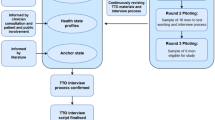Abstract
Measuring preferences for schizophrenia outcomes facilitates meaningful integration of multiple outcome measures and multiple perspectives on treatment outcomes. The Time Tradeoff (TTO) technique, specifically developed for measuring health state preferences, is used widely in health research, but some evidence suggests that the TTO may work less well with schizophrenia than with other health conditions. This study tested the hypotheses that tailoring the time frame of the standard TTO to the course of schizophrenia and simplifying its presentation fromat would improve its feasibility and efficiency. Forty clinicians provided TTO ratings using 1 of 4 combinations of time frame and presentation format. Numeric ratings and quantitative and qualitative measures of feasibility showed that while participants preferred the simpler format, none of the alterations improved feasibility. Participants' ratings were prone to logical inconsistencies and participants found all 4 versions of the TTO confusing and poorly suited to the context of schizophrenia treatment.
Similar content being viewed by others
References
Froberg DG, Kane RL. Methodology for measuring health-state preferences, I: measurement strategies.Journal of Clinical Epidemiology. 1989;42:345–354.
Froberg DG, Kane RL. Methodology for measuring health-state preferences, II: scaling methods.Journal of Clinical Epidemiology. 1989;42:459–471.
Froberg DG, Kane RL. Methodology for measuring health-state preferences, III: population and context effects.Journal of Clinical Epidemiology. 1989;42:585–592.
Froberg DG, Kane RL. Methodology for measuring health-state preferences, IV: progress and a research agenda.Journal of Clinical Epidemiology. 1989;42:675–685.
Gold MR, Patrick DL, Torrance GW, et al. Indentifying and valuing outcomes. In: Gold MR, Siegel JE, Russell LB, Weinstein MC, eds.Cost-Effectiveness in Health and Medicine. New York: Oxford University Press; 1996:82–134.
Kaplan RM, Revicki DA. Methods for assessing relative importance in preference based outcome measures.Quality of Life Research. 1993;2:467–475.
Shumway M, Battle C. Clinicians' preferences for schizophrenia outcomes: a comparison of four methods.Schizophrenia Research. 1995;15:197.
Revicki D, Shakespeare A, Kind P. Preferences for schizophrenia-related health states: a comparison of patients, caregivers, and psychiatrists.International Clinical Psychopharmacology. 1996;11:101–108.
Chouinard G, Albright P. Economic and health state utility determinations for schizophrenic patients treated with risperidone or haloperidol.Journal of Clinical Psychopharmacology. 1997;17:298–307.
Shumway M, Chouljian T, Battle C. Stakeholder preferences for schizophrenia outcomes: an evaluation of assessment methods.Schizophrenia Research. 1997;24:258.
Awad AG, Voruganti LP. Cost-utility analysis in schizophrenia.Journal of Clinical Psychiatry. 1999;60(suppl 3):22–26.
Lee TT, Ziegler JK, Sommi R, et al. Comparison of preferences for health outcomes in schizophrenia among stakeholder groups.Journal of Psychiatric Research. 2000;34:201–210.
Lenert LA, Ziegler J, Lee T, et al. Differences in health values among patients, family members, and providers for outcomes in schizophrenia.Medical Care. 2000;38:1001–1021.
Shumway M. Preference weights for cost-outcome analyses of schizophrenia treatments: comparison of four stakeholder groups.Schizophrenia Bulletin. 2003;29:257–266.
Torrance GW, Thomas WH, Sackett DL. A utility maximization model for evaluation of health care programs.Health Services Research. 1972;7:118–133.
Torrance GW. Utility approach to measuring health-related quality of life.Journal of Chronic Disease. 1987;40:593–600.
Mohide EA, Torrance GW, Streiner DL, et al. Measuring the wellbeing of family caregivers using the time trade-off technique.Journal of Clinical Epidemiology. 1988;41:475–482.
Shumway M, Sentell T, Chouljian T, et al. Assessing preferences for schizophrenia outcomes: comprehension and decision strategies in three assessment methods.Mental Health Services Research. 2003;5:121–135.
Giesler RB, Ashton CM, Brody B, et al. Assessing the performance of utility techniques in the absence of a gold standard.Medical Care. 1999;37:580–588.
Jansen SJT, Stiggelbout AM, Wakker PP, et al. Patients' utilities for cancer treatments: a study of the chained procedure for the standard gamble and time tradeoff.Medical Decision Making. 1998;18:391–399.
Stavem K. Quality of life in epilepsy: comparison of four preference measures.Epilepsy Research. 1998;29:201–209.
Buckingham JK, Birdsall J, Douglas JG. Comparing three versions of the time tradeoff: time for a change?Medical Decision Making. 1996;16:335–347.
van Wijck EEE, Bosch JL, Hunink MGM. Time-tradeoff values and standard-gamble utilities assessed during telephone interviews versus face-to-face interviews.Medical Decision Making. 1998;18:400–405.
Committee on Quality Health Care in America, Institute of Medicine.Crossing the Quality Chasm: A New Health System for the 21st Century. Washington, DC: National Academy Press; 2001.
Creswell JW.Research Design: Qualitative, Quantitative, and Mixed Methods Approaches. Thousand Oaks, Calif: Sage; 2003.
Tashakkori A, Teddlie C.Mixed Methodology: Combining Qualitative And Quantitative Approaches. Thousand Oaks, Calif: Sage; 1998.
Morse JM, Barrett M, Mayan M, Olson K, Spiers J. Verification strategies for establishing reliability and validity in qualitative research.International Journal of Qualitative Methods. 2002;1. Article 2. Available at: http://www.ualberta.ca/~ijqm/. Accessed July 17, 2002.
Shumway M, Chouljian TL, Rozewicz F. Paraphrase procedures for assessing comprehension of health outcome measures: an illustration from schizophrenia research.Evaluation and the Health Professions. 2003;26:73–85.
National Center for Health Statistics.Vital Statistics of the United States, 1989. Vol. 2. Sec 6 life tables. Washington, DC: Public Health Service; 1992.
Chestnut LG, Keller LR, Lambert WE, et al. Measuring heart patients' willingness to pay for changes in angina symptoms.Medical Decision Making. 1996;16:65–77.
Klose T. The contingent evaluation method in health care.Health Policy. 1999;47:97–123.
Lenert LA, Cher DJ, Goldstein MK, et al. The effect of search procedures on utility elicitations.Medical Decision Making. 1998;18:76–83.
Lenert L, Sturley A, DiClemente R, et al. Trading time and risking life: what works for patients. Paper presented at: The Annual Meeting of the Society for Medical Decision Making; October 20, 2002; Baltimore, Md.
Fischer EP, Shumway M, Owen RR. Priorities of consumers, providers, and family members in the treatment of schizophrenia.Psychiatric Services. 2002;53:724–729.
Author information
Authors and Affiliations
Corresponding author
Rights and permissions
About this article
Cite this article
Shumway, M., Chouljian, T.L. & Battle, C.L. Measuring preferences for schizophrenia outcomes with the time tradeoff method. The Journal of Behavioral Health Services & Research 32, 14–26 (2005). https://doi.org/10.1007/BF02287325
Issue Date:
DOI: https://doi.org/10.1007/BF02287325




